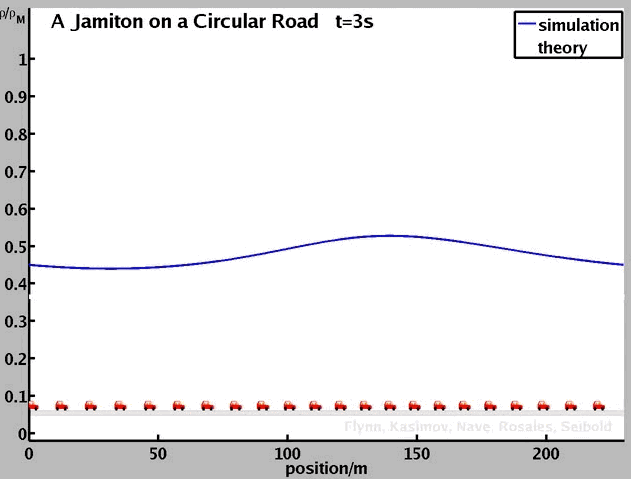How Long It Will Take for the Traffic on This Freeway to Become Normal Again
If you've e'er driven on a highway, you've probably seen it happen. Traffic slows to a clamber, then stops entirely. Minutes afterward, it begins to move again, and then suddenly, you're moving at full speed.
The weirdest part: in that location's no construction, blow, or other possible explanation for the traffic. Why does this happen?
As it turns out, a few different groups of researchers have been using mathematical calculations and real-world experiments to endeavour answering this question. And they think they have the answer. They also take suggestions on how to stop these jams.
Why phantom traffic jams form
If there are enough cars on a highway, any pocket-sized disruptions to the period of traffic tin cause a self-reinforcing concatenation reaction: one car brakes slightly, and the ones behind it restriction just a bit more to avoid hitting information technology, with the braking somewhen amplifying until it produces a wave of stopped or slowed traffic.
"These traffic waves arise from small perturbations in a uniform traffic menstruum, like a bump in the road, or a commuter braking after a moment of inattention," says Benjamin Seibold, a mathematician at Temple University who's worked with colleagues on understanding the phenomenon.
Fifty-fifty when cars exit this traffic moving ridge, though, the moving ridge itself doesn't disappear: it gradually drifts backward, against the direction of traffic. "It'south typically 100 to g meters long, and it unremarkably begins with vehicles running into a sudden increment in density at the commencement, and a drop in velocity," Seibold says. "Then, after that, they slowly advance once more."
He and others developed the concept of these waves (which they telephone call jamitons, because they're analogous to waves in physics called solitons) using estimator algorithms that simulate driving beliefs:

(Seibold et. al.)
Japanese researchers accept also conducted existent-world experiments that come to the aforementioned conclusion. In one, they instructed 22 drivers to drive at the same speed (18.6 mph), and preserve the same amount of infinite betwixt cars, on a small circular road. Inevitably, traffic waves formed:
So who's to blame for these traffic jams?
In i sense, it seems reasonable to arraign these phantom traffic jams on individual drivers. The models indicate that these jams are more likely to class when people drive as fast as possible, then finally restriction when necessary to avoid hitting the car in front of them, triggering a chain reaction.
"If people conceptualize higher traffic densities ahead, and take their feet off the gas earlier and go out more room in front of them — instead of waiting until they accept to brake — that can forbid traffic jams from arising," Seibold says.
Another way to think of it, says Berthold Horn — an MIT calculator scientist who's worked on the same topic — is to try driving and so that you stay halfway between the car in front of you lot and the 1 behind you. This will lead to you avoid sudden braking when possible.
:no_upscale()/cdn.vox-cdn.com/uploads/chorus_asset/file/2487876/141929352.0.jpg)
(Justin Sullivan/Getty Images)
On the other hand, this sort of behavioral change doesn't totally eliminate phantom traffic jams — it merely makes them less likely to form (specifically, it means that a higher density of cars on the road is required for traffic waves to develop). But if there are enough cars on the road, even if people anticipate approaching traffic to the best of their abilities, phantom traffic jams volition form.
"We're usually inclined to recollect that these must be caused past an individual driver," Seibold says. "Merely the models testify that fifty-fifty if all drivers drive past the verbal same rules, and no one does anything incorrect, these waves can still arise."
These jams, in essence, emerge whenever you accept enough humans driving cars on a highway. So the only real way to eliminate them probably involves handing the wheel over to something other than a human driver.
The solution to phantom traffic jams
:no_upscale()/cdn.vox-cdn.com/assets/4522695/google_car.png)
A prototype of Google'southward self-driving car. (Google)
In the short term, there are some things engineers can do to cut downward on these traffic jams.
The straighter and smoother a road is, the less likely the jams are to form, since it means drivers won't be doing as much sudden braking. Most highways are already built to be as straight every bit possible, then it's mainly by better maintaining current ones that this can make a difference.
A more than innovative idea, Seibold says, are variable speed limits, which are already in place in a few places in the US (but are mainly used to alter speeds based on weather weather condition). Using LED signs, speed limits could be decreased in the area leading in to a phantom traffic jam, causing cars to slow downwards gradually, rather than all at once. In some cases, this could pause up the wave.
Finally, Seibold believes a comprehensive solution will come in the form of self-driving cars. Considering they'll exist able to command their speeds with more precision and use data on traffic miles downwards the road, they'll be able to anticipate slow-downs much more effectively than any human.
One motorcar suddenly braking, for instance, could send out a betoken to all the cars within a mile backside it, instructing them to slow downwards gradually, rather than all of a sudden when they get in at the nascent traffic wave. In theory, at least, this will shine out waves of traffic earlier they're able to form.
Source: https://www.vox.com/2014/11/24/7276027/traffic-jam
0 Response to "How Long It Will Take for the Traffic on This Freeway to Become Normal Again"
Postar um comentário